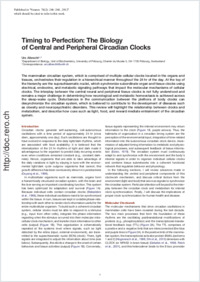Timing to perfection: the biology of central and peripheral circadian clocks
Université de Fribourg
- Albrecht, Urs Department of Biology, Unit of Biochemistry, University of Fribourg, Switzerland
-
25.04.2012
Published in:
- Neuron. - 2012, vol. 74, no. 2, p. 246–260
English
The mammalian circadian system, which is comprised of multiple cellular clocks located in the organs and tissues, orchestrates their regulation in a hierarchical manner throughout the 24 hr of the day. At the top of the hierarchy are the suprachiasmatic nuclei, which synchronize subordinate organ and tissue clocks using electrical, endocrine, and metabolic signaling pathways that impact the molecular mechanisms of cellular clocks. The interplay between the central neural and peripheral tissue clocks is not fully understood and remains a major challenge in determining how neurological and metabolic homeostasis is achieved across the sleep-wake cycle. Disturbances in the communication between the plethora of body clocks can desynchronize the circadian system, which is believed to contribute to the development of diseases such as obesity and neuropsychiatric disorders. This review will highlight the relationship between clocks and metabolism, and describe how cues such as light, food, and reward mediate entrainment of the circadian system.
- Faculty
- Faculté des sciences et de médecine
- Department
- Département de Biologie
- Language
-
- English
- Classification
- Biological sciences
- License
-
License undefined
- Identifiers
-
- RERO DOC 29053
- DOI 10.1016/j.neuron.2012.04.006
- Persistent URL
- https://folia.unifr.ch/global/documents/302208
Statistics
Document views: 393
File downloads:
- pdf: 290
